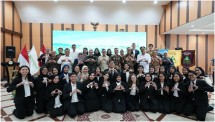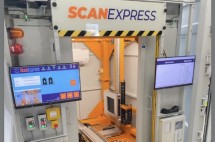Bombana, Cultivate The Establishment Of The Biggest Sugar Industry
By : Dhiyan W Wibowo And Aldo Bella Putra | Saturday, December 16 2017 - 22:00 IWST

Ilustrasi Pabrik Gula (wy)
INDUSTRY.co.id - Bombana, The classic problem in the national sugar industry still revolves around the low level of productivity per hectare on sugarcane plantations.
The problem of sugar factory which is dominated by heritage facility of Dutch East Indies era also decreases national sugar production level. The plan to build the largest sugar factory in Bombana seems to help push the national sugar import level.
Once, when Indonesia was still called the Dutch East Indies, around the 1930s, there were about 179 sugar stand factories, which received the harvest of sugarcane from the total area of sugarcane plantation at that time which is about 150 hectares.
Each hectare was able to produce a fantastic sugar at 14.79 tons per hectare. Compare with the recent sugar industry conditions that are far down.
The number of existing sugarcane plantations has doubled, reaching 398 hectares in 2010. However, the production rate is much lower, to only 5.74 tons per hectare.
The number of sugar factories was also eroded into only about 90 units, most of which are owned by the red plate company is a sugar factory of Dutch heritage.
Meanwhile, based on estimates from the Ministry of Industry in 2016, the national demand for sugar is mentioned at 5.7 million tons, of which 2.8 million tons are white crystals for public consumption, and 2.9 million tons of refined sugar for the needs food and beverage industry.
So far efforts to cover the shortage of sugar needs are done by import, not by seeking a sustainable way in increasing the amount of domestic sugar production. This import step has been practically practiced by the government since 1967.
An irony is for an agrarian country of course. Many factors make Indonesia a sugar importer.
Based on data from the Directorate of Annual Plants and Spices at the Directorate General of Plantation, Ministry of Agriculture, fluctuations is in the amount of sugar production in 2008-2016.
In 2008, sugar production reached 2.6 million tons. The production rate is reduced by about 0.4 million tons per hectare in 2016 to 2.2 million tons.
Although the area is over this period has increased although not significant. In 2008 the area of sugarcane field reached 435 thousand hectares, rose to about 444 thousand hectares in 2016.
Presented by the Director of Annual Plants and Spices Kementan RI, Agus Wahyudi some time ago, the decline in sugar productivity caused a number of things, including climate change, shifting fertility of the land, scarcity of labor to capital.
"Many technical problems both in farmers and in sugar factories," he said as reported by Trubus.
About the capital also makes not many factories that experienced modernization, and still rely on the production facilities of the relic of the Dutch East Indies era.
No doubt efforts to increase productivity are often hampered. Nevertheless, the Ministry of Agriculture continues to increase the productivity of sugarcane and increase its area, with the target of sugar production increased to 3.3 million tons with a total area of 505 hectares of sugar cane in 2020, as explained Agus Wahyudi.
The government's desire is to get support from the private sector soon. PT Jhonlin Batu Mandiri is planning to disburse Rp 2.2 trillion investments to develop integrated sugar cane and livestock plantations in Bombana district, Southeast Sulawesi.
The company mentioned will utilize Tina Orima Production Forest Management Unit (KPHP), Bombana for that purpose.
The area of 20,000 hectares in KPHP Tina Orima will be used for sugar cane development in cooperation with the community. Currently the community has prepared a plasma plant to be developed into the sugar cane development area.
Cattle farms will be developed from sugarcane farms in an integrated manner, considering that the harvested cane can be a quality feed for cattle.
Minister of Agriculture Andi Amran Sulaiman, after planting sugar cane at Tinabite sugar plantation in North Rarowatu sub-district, Bombana regency, said that this sugar cane planting program is part of stepping up the national sugar production, as well as closing the imported sugar tap.
The program is also part of a national program launched by President Joko Widodo to achieve national sugar and sugar self-sufficiency.
We must support the self-sufficiency program of this national sugar cane," said Amran.
In addition to the development of sugarcane plantations integrated with cattle farms, in the same district is also planned to be built the largest sugar factory.
Amran Sulaiman said, in accordance with the order of the President of Indonesia Joko Widodo, it plans to build ten sugar factories, of which five plants are already completed and operational.
"So this is the first directive of the President, the President's order if you want to be self-sufficient, build 10 sugar mills now finished in OKI (Ogan Komering Ilir), probably milled in November, then Dompu is milled, two in East Java and Lampung" Amran said as quoted by RMOL.
According to him, the plan to build the biggest sugar factory in Southeast Sulawesi is an initiative from investors who are ready to invest Rp 4 trillion.
He hopes that the target of building 10 sugar mills will continue to be achieved. After construction in Bombana is teralisir, it hopes similar steps can also be done in Papua, West Nusa Tenggara, or East Nusa Tenggara, and Maluku.
It still takes five here. If Kendari can accommodate two, I prepare two. But if one, one wrote. We move back to Papua, or NTB already, maybe NTT, or elsewhere, Maluku," he said.
He also asked the local community not to worry about the sugar factory development plan, because it has received commitment from the management company to empower local human resources.
The President's suggestion if you want Self-Sufficiency, builds 10 sugar factories. Now it's finished 5 units. Incidentally in Sultra Agroklimatnya suitable, and very good, then we push. We built a sugar factory with a capacity of 10,000 TCD (tones of cane per day) and is the largest in Eastern Indonesia, Amran said.
Meanwhile, member of Commission IV of the House of Representatives, Andi Akmal Pasluddin reminded the government that the construction of a sugar factory usually takes a very long time.
Therefore, it is required consistency from the government to continue to develop the plan despite having to change regime.
Akmal himself expressed apriesiasinya if this plan will actually materialize.
According to him, the construction of a new sugar mill is now urgent, given the poor quality of sugar farmers who are likely to be affected by the low efficiency of the Dutch heritage factory.
In addition, the capacity of most sugar mills is not great. The highly efficient sugar mill looks at the Kebon Agung sugar factory in East Java," Akmal said recently.
The construction of a new large-capacity sugar mill will also provide an efficiency solution to a high level of recovery.
Currently according to Akmal the best rendemen rate is only around 8%. Even in West Java, the area of sugar cane becomes less than 7% sugar.
Read Also
Today's Industry

Jumat, 02 Mei 2025 - 10:46 WIB
Binawan and Government Support Indonesian Nurses in Europe through Scholarships
In the midst of the viral #KaburAjaDulu hashtag as a symbol of the young generation's disappointment with domestic working conditions, Binawan responded with real action: dispatching Indonesian…

Jumat, 28 Maret 2025 - 22:21 WIB
SUNeVision Initiates MEGA IDC Phase Two Development
SUNeVision, the technology arm of Sun Hung Kai Properties (SHKP), today announced the commencement of construction for Phase Two of MEGA IDC in Tseung Kwan O. As Hong Kong's largest data centre…

Jumat, 28 Maret 2025 - 22:07 WIB
TDL Records New Revenue Record of IDR 25 Trillion in 2024 Ahead of 50th Anniversary
PT Metrodata Electronics Tbk (MTDL), the largest technology Company with the most complete IT and telecommunications products in Indonesia, managed to record a revenue of IDR 25 trillion in…

Jumat, 28 Maret 2025 - 22:00 WIB
Wireless Logic Selected By Thales As IoT Connectivity Partner
Wireless Logic, a global leader in IoT connectivity solutions has been selected by Thales, a global leader in advanced eSIM technologies, to enable secure, scalable and resilient IoT connectivity…

Jumat, 28 Maret 2025 - 21:53 WIB
Microvista Expands International Presence with Mobile CT System ScanExpress
The German specialist in industrial computed tomography and non-destructive testing, Microvista, announces the European expansion of its innovative mobile CT system, ScanExpress. The system…
















News Comment